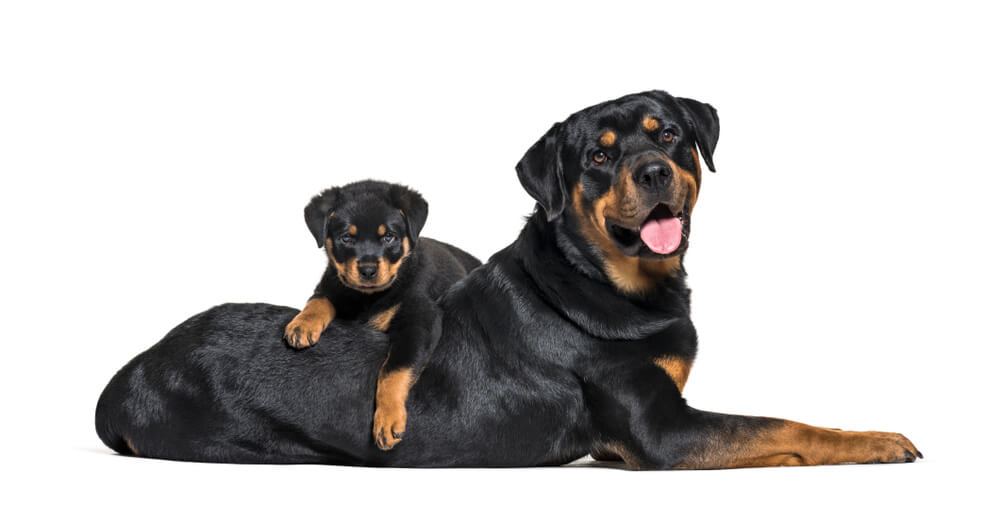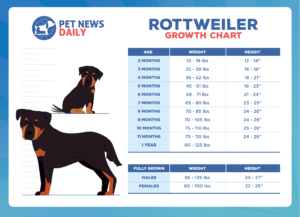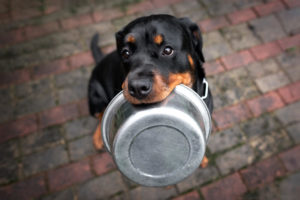If you recently brought home a Rottweiler puppy, there’s one thing you know: It’s going to get big! Just how big will your puppy be when he’s full-grown? We consulted with our veterinarian, Dr. Jennifer Coates, who reviewed and approved data about puppy weights and sizes, which we then used to create a convenient Rottweiler growth chart. You can use this as a reference to see how your puppy compares to the average.
The chart shows you a Rottweiler’s monthly average weight range during the growing phase. You can also refer to the puppy weight calculator to get an idea of how big your puppy is likely to get.
In This Article
Rottweiler Growth Chart
- 1 year: 80-125 pounds
- Fully grown males: 95-135 pounds, 24-27 inches
- Fully grown females: 80-100 pounds, 22-25 inches
Text Transcript of the Rottweiler Growth Chart
| Rottweiler – Age | Weight | Weight |
|---|---|---|
| 2 months 3 months 4 months 5 months 6 months 7 months 8 months 9 months 10 months 11 months 1 year |
10-16 pounds 25-39 pounds 36-52 pounds 45-61 pounds 59-71 pounds 65-80 pounds 70-85 pounds 70-105 pounds 75-110 pounds 75-115 pounds 80-125 pounds |
12-14” 16-18” 18-21” 19-23” 21-24” 23-25” 24-26” 24-26” 24-26” 25-26”
24-27 inches |
Also known affectionately as Rotties, the Rottweiler is one of the most popular dogs in the United States. Powerful, protective, and loyal, they’re famous for their guarding instincts, but they can also be fun and gentle playmates.1
Descended from ancient Roman dogs, Rottweilers have been used throughout history to perform many different jobs. Initially herding animals, they also guarded cattlemen’s money by carrying it around their necks in a pouch. Today they are highly versatile and can be trained as service dogs, therapy dogs, obedience competitors, police dogs, guide dogs, customs inspectors, carting dogs, and devoted companions.2
What Are the Growth Stages of a Rottweiler?
As your Rottweiler puppy grows, she will go through several stages that mark milestones for her development and behavior.
Birth to 10 Weeks
She’ll experience the most growth during her first week of life when she doubles in size from her birth weight. She’ll continue to grow at a rapid rate until around 6-8 weeks of age. At that point, she’s usually ready to be weaned off her mother’s milk and taken home with you.
Up through about 10 weeks, her growth plates (soft area of cartilage from which bones grow and extend) and joints will still be soft as they haven’t completely developed yet. She will weigh between 22-26 pounds and reach up to about 15 inches tall at the shoulder.
10 Weeks to 3 Months
From that point on, your puppy will continue to grow, gaining a little over two pounds per week until she reaches 8-9 months of age. By three months, she should have gained another about 10-11 pounds, and her growth rate will begin to slow a little, though she will continue to grow through 18 months and sometimes up to two-to-three years.
3 Months to 7 Months
Between three-to-four months, she will have reached about 60 percent of her adult height, but only about 30 percent of her adult weight.
When your pup turns seven months old, he will have gained about 65 percent of his adult weight and will leave his most rapid growth behind. He will weigh between 79-99 pounds with a height of 24-26 inches.
7 Months to 12 Months
Between 7 and 12 months, he’ll enter his teen years, and may display some typical teenager-type behavior where he ignores commands or gets into things he shouldn’t! Consistent positive reinforcement will get you through this period. You’ll also notice that he’s still growing and that he has all his adult, permanent teeth.
At 12 months, most Rotties are considered close to full-grown. The growth plates harden and fully close, and their bodies will look mature. Keep in mind, however, that your pal can still put on weight, with some growing until they are near three years old. This is because they have big muscles, broad chests, and big heads that take time to develop fully.
Tips on Rottweiler Nutrition for Optimal Growth
To make sure your Rottie reaches her growth milestones, feed a high-quality large-breed food.3 These foods provide the proper nutrition for a big dog like a Rottweiler but slow the growth rate to decrease the risk of joint problems.
Make sure the food is high in protein (real meat should be the first ingredient) to support those large, strong muscles. Do be cautious about fat content. Rottweilers are prone to obesity, and a high-fat diet can cause problems in the future. A healthy amount of fat content is around 12-16 percent.
Choose treats that are high in protein, not fat. Good options include freeze-dried liver, tendons, and other meats that don’t have a lot of sugar or fat in them. Feed these treats only occasionally and refrain from giving your dog people food.
You may be tempted to feed more food to help your dog grow bigger, but this can lead to over-conditioning and future joint problems, so stick with the recommended amount of food. It’s also best to feed at least two smaller meals a day. Feeding too much at once can overfill your dog’s stomach and deep chest area with food which can lead to bloat.
As your Rottie grows, you can also check for ideal weight by examining the ribs and waist. You should be able to easily feel but not see the ribs and note a well-proportioned waist when looking at your dog from the top.
How Big Do Rottweilers Get?
There are a few ways to estimate how big your Rottweiler will grow.
First, consider your dog’s genetics. American lines are often smaller than European lines, and dogs bred as pets may be smaller than those bred to be show or working dogs. Ask the breeder for information on your dog’s parents. Their size and weight will greatly influence your dog’s adult size.
Next, check your dog’s features. If your Rottweiler has a longer, narrower snout and narrow chest, she will likely weigh less than one that has a shorter, blunter snout and broad chest. Check the dog’s paws as well. If they look too big when compared to the rest of the dog’s body, this is a classic sign that your dog is still growing.
Another indicator of your Rottweiler’s final size is its gender. As with many other animals, males are typically larger than females.4 Whereas females can weigh between 80-100 pounds, a male can weigh between 95-135 pounds.
Another way to estimate your puppy’s final growth weight is to use this simple formula:5
(Current weight/Age in weeks) x 52.
For example, if your pup is 25 pounds at 16 weeks of age, the formula would look like this:
- (25/16) = 1.57 (rounded up)
- 1.57 x 52 = 82 (rounded up)
The best time to check your Rottweiler with this formula is when they reach about 16 weeks of age.
You can also use our puppy size predictor to find out how big your puppy might get as an adult. Or, if you want to see the growth rates of other dogs, we’ve also created a Golden Retriever size chart, Great Dane growth chart, Chihuahua size chart, and Labrador growth chart.
When Do Rottweilers Stop Growing?
As a large-sized dog breed, Rottweilers will take longer than many other dogs to reach their full size. By the time your dog is one year old, he will be near his full height and weight, but he is likely to keep growing for at least another year. Very large, typically male Rottweilers may need up to three years to finish filling out.
If you have any concerns about how your puppy is doing in terms of growth, be sure to check with your veterinarian.
Things That Affect Growth
Do be careful not to overexercise your Rottweiler puppy while she’s still growing. Their large bones take time to develop, and if you run long distances, you could be setting your dog up for joint problems later in life.
Exercise is important, though, so play games like swimming, tug of war, fetch, and other gentle forms of exercise—preferably on soft grass or ground rather than pavement—until they reach about a year old. These types of exercises help them to build their muscles. Daily walks are also a must.
Rottweilers, like many large breed dogs, are prone to hip dysplasia or arthritis. Even as puppies these health issues can cause the muscles to atrophy. Feeding high-quality large-breed puppy food will help prevent this. A good breeder should also screen for these issues before selling you the dog.
Intestinal problems can stunt growth in Rottweiler puppies. If you notice that your dog is not gaining weight like she should, it could be that she has parasites like worms (hookworms, roundworms, etc.) or another digestive issue. These are typically easily treated after which your puppy can catch up on her growth.
Rottweilers are also commonly affected by heart disease, like aortic stenosis. This occurs when the aortic valve narrows, forcing the heart to work harder to force blood through the narrowed valve. Over time, this can damage the heart muscle, leading to a heart attack and death. You can’t prevent the condition, but if your dog has it, there are steps you can take to help support heart function. Check with your veterinarian for more information.
Rottweiler Weight Calculator
PUPPY WEIGHT CALCULATOR
Frequently Asked Questions
As a large breed, Rottweilers take more time to grow than most other dogs. They will be close to their adult size by one year old but then can continue to grow for another one or two years. Females will reach their full adult weight and height faster than males.
At seven months, your Rottweiler pup should be between 65 and 80 pounds and 23-25 inches high at the shoulder, depending on its gender and heritage. (Some may be larger.)
Rottweilers are large-breed dogs, so most of them will be big dogs. How big your specific puppy will get depends on many factors, including:
- Gender: males grow larger than females.
- Heritage: puppies usually take after their parents. American breeds are usually smaller than European breeds.
- Paw size: as long as your dog’s paws look out of proportion to the rest of his body, he’s still growing.
- Physical characteristics: dogs with longer, narrower snouts and narrow chests will be smaller than those with blunt noses and broad chests.
At six months, your Rottweiler has gained about 60 percent or two-thirds of her final adult size. You can expect her to keep growing through her first year, and then a little more through the first 18 months to two years. Males can continue to fill out until three years of age.
Usually, a Rottweiler’s head will grow faster than the rest of its body, so it’s normal for the head to look out of proportion to the body until the dog is completely grown. Males will have bigger head sizes than females and can take up to three years to fully develop their heads.
The skull doesn’t really “split,” however. The term splitting refers to the maturation of the breed’s head, which widens and broadens as it grows. Particularly as the muscles develop, it can create a line or indent along the dog’s head that appears like a split, but it’s all muscle. You may notice this forming between one and three years in your dog.
It takes time for a Rottweiler to grow, mature, and become territorial. Usually, you can expect your dog to start showing guarding behaviors around the age of two years old, though it differs from one dog to another. Keep in mind that your dog needs time to bond with you and to feel like your house is her home before taking any action.
As with guarding behavior, you are likely to notice more mature, calmer behavior once your dog turns two years old. Then he will continue to calm down until he reaches four-to-five years old.
It all depends on how you’re training him, however. A dog receiving daily exercise is likely to be calmer than one that is kept cooped up. The AKC recommends two hours of exercise a day for your Rottweiler. Obedience training will help too and can begin as early as eight weeks old.
Rottweilers grow quickly early in life, and later experience growth spurts, but on the whole, they take their time reaching maturity. Unlike a small dog which may be fully grown by 6-8 months, a Rottweiler needs a full 18 months to three years to reach its final size.
Additional Resources
If you’re looking for more information about dog growth in general, we’ve created a puppy weight calculator, an in-depth guide to how heavy your dog should be, and a series of growth charts for different breeds (and dogs and mixed breeds in general):
- Great Dane Growth Chart
- Goldendoodle Growth Chart
- Chihuahua Growth Chart
- Golden Retriever Growth Chart
- Labrador Growth Chart
- Dog Growth Chart
- Mixed Breed Growth Chart
- Rottweiler Growth Chart
- Pit Bull Growth Chart
- Australian Shepherd Growth Chart
- French Bulldog Growth Chart
- Great Pyrenees Growth Chart
- Standard Poodle Growth Chart
- Bernedoodle Growth Chart
- Husky Growth Chart
Article Sources
Pet News Daily uses only high-quality sources, including peer-reviewed studies, to support the facts within our articles. Read our editorial process to learn more about how we fact-check and keep our content accurate, reliable, and trustworthy.
- Rottweiler dog breed information. (n.d.). American Kennel Club. https://www.akc.org/dog-breeds/rottweiler/
- Reisen, J. (2021, May 27). 9 things to know about rottweilers – American Kennel Club. American Kennel Club. https://www.akc.org/expert-advice/lifestyle/9-things-you-didnt-know-about-the-rottweiler/
- Rottweiler dog breed information | VCA animal hospitals. (n.d.). Vca. https://vcahospitals.com/know-your-pet/dog-breeds/rottweiler
- Staff, A. (2017, May 11). Breed weight chart – American Kennel Club. American Kennel Club. https://www.akc.org/expert-advice/nutrition/breed-weight-chart/
- Puppy growth: What you need to know. (n.d.). Bond Vet. https://bondvet.com/b/puppy-growth



